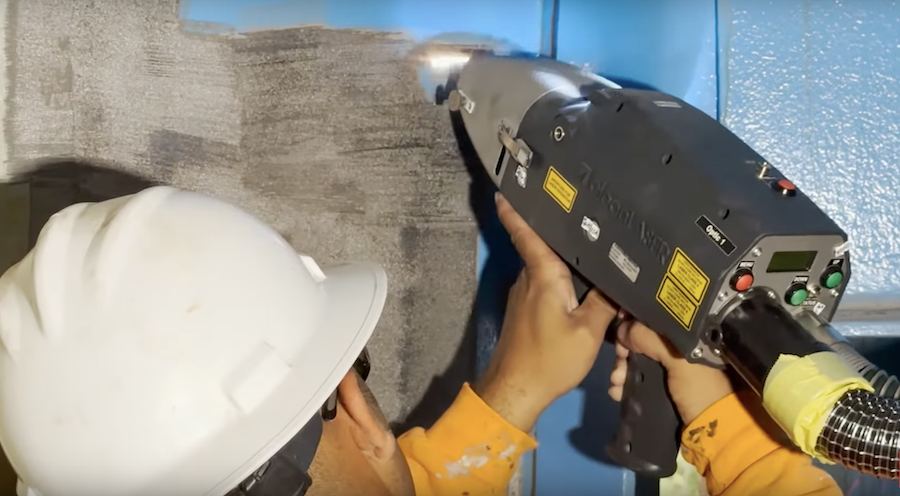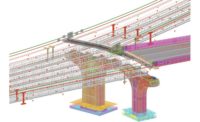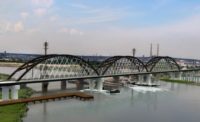It’s not quite a ray gun, nor is it a hand-held vacuum.
But a 1,000-watt laser that crews recently tested on a Connecticut Dept. of Transportation bridge performed as a combination of both—vaporizing paint and rust off the ends of 36-in. steel H-beams with a laser, then capturing the vaporized residue by suction with a fume extractor filter unit.
Unlike the traditional methods of abrasive blasting, chemical stripping or power tool cleaning, the 14-day operation required no heavy equipment, containment systems or traffic closures.
The pilot project, completed last month, came about because of an Instagram video.
Jagdeesh Gopal, director of bridge engineering at GM2, a consultant to the state DOT, saw the laser being used in a manufacturing environment. “We were doing a type of repair where I thought it could be directly usable,” he says. “I went down that rabbit hole and investigated what’s been done on bridges.”
The Virginia Dept. of Transportation has used laser ablation removal for bridge maintenance for several years, after Dino DeFendini, field services manager at DRMP Inc., saw a demonstration by laser provider Adapt Laser. “It’s really cool to see how it’s come along,” he says. “The footprint of the machinery is more compact, the laser is more powerful and precise, and it duplicates how we typically remove paint via DOT procedures.”
He adds that disposal costs "are reduced to 10% of what they would normally would be. [The waste] doesn’t have to be as contained in the same manner, which reduces shipping costs and footprint. You use 150 to 300 gallons of diesel almost daily with standard [methods]—this eradicates that.”
For the Plantsville bridge, contractor Best-Tec removed paint and rust from the beam ends at 36 locations prior to welding shear pins to the beam web. Temporary decking suspended from the bridge beams provided access. Laser ablation equipment was delivered to the site and operated from within an enclosed trailer that did not interfere with traffic or use of the pedestrian walkway. The laser power supply remained in the equipment trailer while the beam was delivered by 150-ft-long fiber optic cables to a hand-held laser end effector, according to Best-Tec.
Technicians swept the scanned laser beam over the surface, removing paint and rust to expose clean base surfaces. Vaporized paint and rust residues were captured immediately at the laser end effector by suction from a filter unit. The extractor had three stages of filtration: particle filters with a self-cleaning mechanism, activated carbon for gas, and a high-efficiency particulate air filter.
Sandblasting would have generated an estimated 9,000 to 12,000 lb of spent blast media mixed with hazardous paint residue. The waste generated by the laser ablation coatings removal process was roughly 40 lb of dry powder, according to officials at Best-Tec and Adapt Laser.
“It’s the greenest removal method—you can’t get any greener,” says Greg Kleinrichert, vice president at Best-Tec. “You’re bringing the incinerator to the paint, not visa versa.”
This abrasive laser method has been used in the automotive, welding, military and aerospace industries, but it is still relatively new to the infrastructure world. Tim Niemeier, Adapt Laser vice president, expects the Association for Materials Protection and Performance to adopt a standard and technical guide for the method soon.
According to the American Association of State Highway and Transportation Officials, highway agencies undertake bridge painting every five to 15 years as a preventive maintenance activity to extend the life of steel bridges.
Laser ablation coatings removal "offers significant cost savings, health and environmental benefits over traditional methods," according to the association website. It "reduces the release of airborne contaminants to extremely low levels, which in turn, improves industrial hygiene and safety of workers, requires less personal protective equipment, and enhances safe disposal of hazardous waste." Further, it is "highly effective and efficient as no containment structure is needed and 'touch up' or spot repairs can be done."
The process is "a little more expensive per square foot” compared to traditional methods in major removal jobs, says DeFendini. “As [the technology] continues to improve, that will be reduced significantly over time.” He adds that it’s been cost-competitive for maintenance of VDOT bridges: "Maybe not for 3,000 sq ft of steel—but for 200 sq ft, it’s very competitive.”
Gopal adds that the process is slow. “The laser can only take out certain amounts of paint at a time. But it cleans to a nice finish that is almost perfect for the application” of new paint, he says. As the cost of lasers go down, multiple workers might use them in tandem, he adds.
Kleinrichert concurs that the technology has potential to increase in speed and types of applications. “Hopefully the lasers will increase to 2,000 Watts or other levels,” he says. “I see this expanding for different applications, like removing salts that corrode the metal.”
Niemeier adds that the technology is well suited to future automation of this particular construction task: “Robots will be doing this,” he says.





Post a comment to this article
Report Abusive Comment